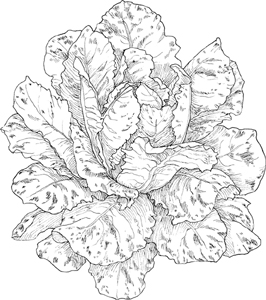
BOTANICAL NAME: Lactuca sativa
FAMILY: Asteraceae

Philip Miller was not the first plantsman to discuss Aleppo lettuce, but in the 1731 edition of his Gardener’s Dictionary he provided a few comments on growing it. He noted that it was much appreciated “for the beauty of its spotted leaves” but that later in the season other lettuces were preferred, including Silesia, Brown Dutch, Imperial, White Cos, and Red Capuchin, all varieties that are still available today. It has been suggested that Dr. William Sherrard (1659–1728), British consul at Smyrna from about 1703 to 1718, was the first to send out seed for this lettuce, but this has not been adequately documented. All that can be said with certainty is that the lettuce sent to Europe came from Aleppo, Syria, and that it was evidently a variety that had been grown in Syria for a long time. It is a cos type, or romaine as we call it in the United States, a form of lettuce that can be traced to ancient Mesopotamia.
Those large, long, stiff-leafed sorts were consciously selected by Syrian gardeners so that the leaves would develop strong ribs and spoon-shaped foliage. The reason for this was simple: the lettuces were used as an edible scoop or spoon when eating tabbouleh-like foods. This method of eating dips and purees was evidently widespread throughout Byzantium and was actually first noted by Europeans on the island of Cos, while it was still under the control of the Hospitallers.
Spotted Aleppo, with its fascinating history running back into the Middle Ages, was also grown in colonial America. Philadelphia seedsman Peter Crowells advertised the seed in 1786, and many seed catalogs mention it down into the 1870s. Then it disappeared. This puzzling situation for a handsome lettuce that was once so popular caused me to wonder whether it was in fact extinct or simply stored away in a seed collection under another name. The key lay in Abbé Rozier’s 1785 encyclopedia on agriculture.
Rozier referred to Spotted Aleppo as romaine flagellée but noted that many country people in France referred to cos-type lettuces as chicons. Flagellé and panaché are often used interchangeably by French seedsmen to describe lettuces with spots or flecks. Thus, after several years of inquiring, and taking into account old methods of naming lettuce, I found something promising called chicon panaché in a private seed collection in France. Seed was duly planted and the resulting ten-inch heads (depicted in the drawing) proved to be identical to the illustrations of Spotted Aleppo published by Vilmorin-Andrieux in The Vegetable Garden, a book that is now treated like the bible of heirloom vegetables. One could say that rediscovering Spotted Aleppo under an old alias was purely a matter of luck. If so, then it was luck based on a well-informed hunch. (In fact, much of the research on plants is carried out this way.)
Sometimes one happy discovery leads to another. By chance, while reading through some old German agricultural tracts, I discovered a 1793 reference to a dwarf variety of Spotted Aleppo developed in Germany for cold-frame culture. It was called Forellenschuss (trout speckles) and it is still one of the most popular of the dwarf lettuces sold to fine restaurants in this country. Very few people realize that it is an eighteenth-century heirloom or that it is genetically connected to old Spotted Aleppo. Knowing this history does not change the flavor of these delightful lettuces, but the dining experience is greatly enriched when the spirit of the past can stimulate the palate.